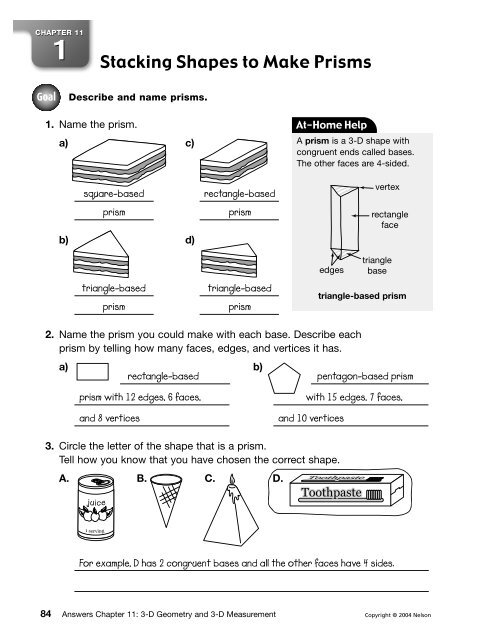You also want an ePaper? Increase the reach of your titles
YUMPU automatically turns print PDFs into web optimized ePapers that Google loves.
CHAPTER 111<strong>Stacking</strong> <strong>Shapes</strong> <strong>to</strong> <strong>Make</strong> <strong>Prisms</strong>GoalDescribe and name prisms.1. Name the prism.a) c)square-basedprismb) d)triangle-basedprismrectangle-basedprismtriangle-basedprismAt-Home HelpA prism is a 3-D shape withcongruent ends called bases.The other faces are 4-sided.edgesvertexrectanglefacetrianglebasetriangle-based prism2. Name the prism you could make with each base. Describe eachprism by telling how many faces, edges, and vertices it has.a) b)rectangle-basedpentagon-based prismprism with 12 edges, 6 faces,and 8 verticeswith 15 edges, 7 faces,and 10 vertices3. Circle the letter of the shape that is a prism.Tell how you know that you have chosen the correct shape.A. B. C. D.For example, D has 2 congruent bases and all the other faces have 4 sides.84 Answers Chapter 11: 3-D Geometry and 3-D Measurement Copyright © 2004 Nelson
CHAPTER 114Building with 3-D <strong>Shapes</strong>GoalBuild a structure with 3-D shapes.You will need boxes, cans, scissors, and tape.1. a) Find 3-D shapes that you coulduse <strong>to</strong> build a structure.At-Home HelpStructures that we see every dayare built from basic 3-D shapes.b) Plan a structure that you can build withsome of the 3-D shapes you found.c) Build your structure. Use tape if necessary.d) Sketch your structure on the right side of this page.e) Describe your structure using math language.Answers will vary.f) Explain how you built your structure.Answers will vary.Copyright © 2004 Nelson Answers Chapter 11: 3-D Geometry and 3-D Measurement 87
CHAPTER 116Solve Problems About CombinationsGoalSolve problems using a table <strong>to</strong> record combinations.Show your work.1. Julia has 3 different ice cream scoops:200 mL, 100 mL, and 50 mL.a) What possible amounts of ice cream canbe measured without refilling the scoops?CombinationMeasure1 scoop 200 mL 200 mL1 scoop 100 mL 100 mL1 scoop 50 mL 50 mL2 scoops 200 mL + 100 mL 300 mL2 scoops 200 mL + 50 mL 250 mL2 scoops 100 mL + 50 mL 150 mL3 scoops 200 mL + 100 mL + 50 mL 350 mLb) What possible sizes of ice-cream conescan be made if there are 2 scoops in eachcone? You can refill scoops.CombinationMeasure2 scoops same 200 mL + 200 mL 400 mL2 scoops same 100 mL + 100 mL 200 mL2 scoops same 50 mL + 50 mL 100 mL2 scoops different 200 mL + 100 mL 300 mL2 scoops different 200 mL + 50 mL 250 mL2 scoops different 100 mL + 50 mL 150 mLAt-Home HelpTo find the different measuresthat can be made using a 5 mL,a 15 mL, and a 25 mL spoonwithout refilling any of the spoons,it is helpful <strong>to</strong> make a table.5 mL25 mL15 mLCombination Measurespoon alone5 mL 5 mLspoon alone15 mL 15 mLspoon alone25 mL 25 mL2 spoons5 mL + 15 mL 20 mL2 spoons5 mL + 25 mL 30 mL2 spoons15 mL + 25 mL 40 mL3 spoons5 mL + 15 mL +25 mL 45 mLCopyright © 2004 Nelson Answers Chapter 11: 3-D Geometry and 3-D Measurement 89
CHAPTER 117Estimating and Measuring MassGoalEstimate and measure the masses of objects.1. Which would you use <strong>to</strong> measure the massof each item: grams or kilograms?a) a watermelonkilogramsb) a <strong>to</strong>othbrushgramsc) a bag of popcorngramsd) a wagonkilogramsAt-Home HelpMass is the amount of matter inan object. Mass can be measuredin grams (g) or kilograms (kg).1000 g = 1 kgBREAD2. Find several full containers that are measured ingrams or kilograms. Dry items, such as bar soap,cereal, bread, rice, nuts, and other snack foodsusually have mass units. (The mass of thepackaging is not included in the mass given.)RICEBREAD3. a) Find 5 objects of different sizes without anymasses given. You can use, for example, a shoe,a book, a <strong>to</strong>y, a plate, a cushion, or a can of pop.Record the items in the chart below.b) Compare each object <strong>to</strong> the items you found inQuestion 2 and estimate the mass of the object.Record your estimates in the chart below.ItemDad’s shoeMy mass estimate500 gAnswers will vary.4. Take 1 or 2 of the objects from Question 3 <strong>to</strong> school <strong>to</strong>morrow.Measure their masses <strong>to</strong> check your estimates.90 Answers Chapter 11: 3-D Geometry and 3-D Measurement Copyright © 2004 Nelson
CHAPTER 11Test YourselfCircle the correct answer.1. Which prism could be made with this base?A. rectangle-based prism C. square-based prismB. pentagon-based prism D. triangle-based prism2. Which statement is not true about prisms?E. <strong>Prisms</strong> are named from the shape of their bases.F. The bases are always congruent.G. The faces that are not bases are all different.H. <strong>Prisms</strong> can be made by stacking the same shape.3. What is true about all pyramids?A. They have some triangle faces. C. They have exactly 1 vertex.B. They have more than 5 faces. D. They have 1 square base.4. Which net would build this shape?E. F. G. H.5. Which capacity best describes a small juice box?A. 200 L B. 200 mL C. 2 L D. 2 mL6. There are 3 sizes of pails: 1 L, 2 L, and 5 L. Which is not apossible amount that can be carried in 2 pails of different sizes?E. 8 L F. 7 L G. 6 L H. 3 L7. Which mass is the most reasonable for a textbook?A. 20 kg B. 30 g C. 2 kg D. 200 gCopyright © 2004 Nelson Answers Chapter 11: 3-D Geometry and 3-D Measurement 91

















